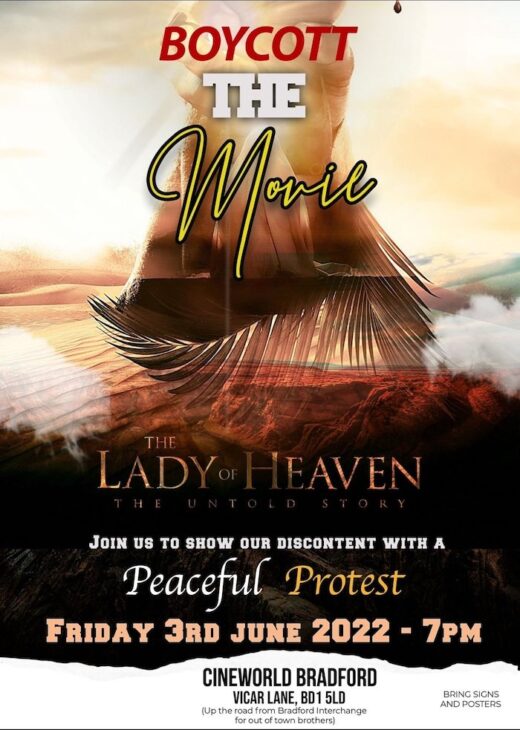‘Free speech’ irrelevant to Batley cartoon row

This week a teacher at a school in Batley, Yorkshire was suspended after showing his year 9 (aged 13-14) pupils, some of them Muslims, a cartoon originating with the French magazine Charlie Hebdo depicting the Prophet Muhammad (sall’ Allahu ‘alaihi wa sallam) with the exaggerated facial features characteristic of that publication and a bomb in his turban, then invited the class to discuss whether they or the attackers were to blame for the massacre of their writers and staff. This has led to demonstrations outside the school by a group of angry Muslim parents demanding he be sacked and/or charged with inciting hatred on religious grounds; the school has reverted to online learning as it had been until the beginning of March. What I want to discuss here is a detail I was told on social media: that the teacher told his pupils that some of them would find it offensive, but that it was his right to freedom of expression, as per “British values”, to do so. Similar claims have been made by others, often with the suggestion that Muslims could leave the country if they do not like it. There has also been criticism of the school for suspending the teacher; they have been accused of caving in to ‘thugs’ or the ‘mob’ (which was actually an orderly group of protesters) while the local authority has been accused among other things of not considering how the matter affects “the overall health of British democracy” by not coming out in condemnation (the school is an academy so out of their control).
To put it simply, free speech is not relevant if you are a teacher in front of a group of pupils. It applies in wider society and the media; anyone can criticise any political figure, any religious figure past or present, any industrialist or entrepreneur or pop star they like as long as they do not incite violence or make false claims about a living person. The difference between someone like Rod Liddle writing some offensive drivel in the Spectator and a teacher spouting the same stuff in front of a group of 13- and 14-year-olds is that we can call Rod Liddle a jerk (or worse) and face no consequences. A pupil who says the same to a racist teacher could be punished; although it’s no longer legal to physically assault them, they could be sent out of class, be kept behind after school or lose their place in an extra-curricular activity. A teacher who shares this kind of material is also sowing the seeds of racism and bullying among the pupils and giving them the impression that this is acceptable or that the ideas are true or valid. Teachers have responsibility; their freedom of speech is something they leave at the gate or at least the staff room door. (In the recent past, teachers were not allowed to tell pupils anything that gave the impression that homosexuality was acceptable, and civil servants are not allowed to express political opinions in public to preserve the institution’s neutrality. So, the right to cause offence isn’t that much of a British value; it has its limits.)
The Prophet (sall’ Allahu ‘alaihi wa sallam) forbade depictions of human beings or animals, and the Sahaba (may Allah be pleased with him) accordingly left no visual representations of themselves or him. We have to rely on verbal descriptions of his physical form but, most importantly, his words and behaviour and the same is true of every mainstream Muslim scholar and leader until the advent of photography. Most scholars regard photographs not to be equivalent to hand-drawn pictures and many will allow students and others to take pictures of them, though not all. The upshot is that such pictures tend to be drawn by those with hostile intent. The Danish cartoons were not only derogatory to the Prophet himself but were also racist: they represented a stereotype of a nasty Arab with an angry, brooding face and the obligatory bomb in the turban, an image repeated in one of the Charlie Hebdo cartoons. The bomb gives the clear impression that terrorism has approval from the very top, which (even taking into account the fact that gunpowder and bombs had not been invented in the 7th century) it actually does not; vigilantism and banditry are not allowed in Islam at all.
The Danish cartoons are 16 years old, older than the children involved in this latest incident. As the cartoons are a historical fact, it may become necessary to reproduce them to show people what the fuss was about (I do not need to do so here; you can google them). In my opinion, it is not an insult to reproduce them; the insult is in claiming they are of the Prophet (sall’ Allahu ‘alaihi wa sallam), as the newspaper that commissioned them did when it published them, rather than a mere ugly stereotype of an Arab. An ugly, threatening man in a turban would more likely make Muslims think of Abu Jahl (Mr Ignorance), the violent pagan enemy of the early Muslims, or some modern Hindu extremists as the turban is popular among Hindus as well as Muslims. However, it isn’t a teacher’s place to force this issue on a group of 13-year-olds, cavalierly justifying it as his “free speech”, without a thought to the consequences for them. It’s true, there is no blasphemy law in this country anymore and there never was one about Islam, and non-Muslims are not expected to observe every detail of Islamic law about how Islam or the Prophet (sall’ Allahu ‘alaihi wa sallam) is talked about, in our presence or otherwise, but teachers are in a position of trust and are supposed to consider their pupils’ well-being and maintaining peace and order in their schools when conducting lessons and choosing material. If teachers fail to do this, they must be disciplined and sacked if necessary. It’s an internal matter and what the rest of the country thinks is of no importance.
Image source: J Thomas, via Geograph. Released under the Creative Commons Attribution-ShareAlike (BY-SA) 2.0 licence.


